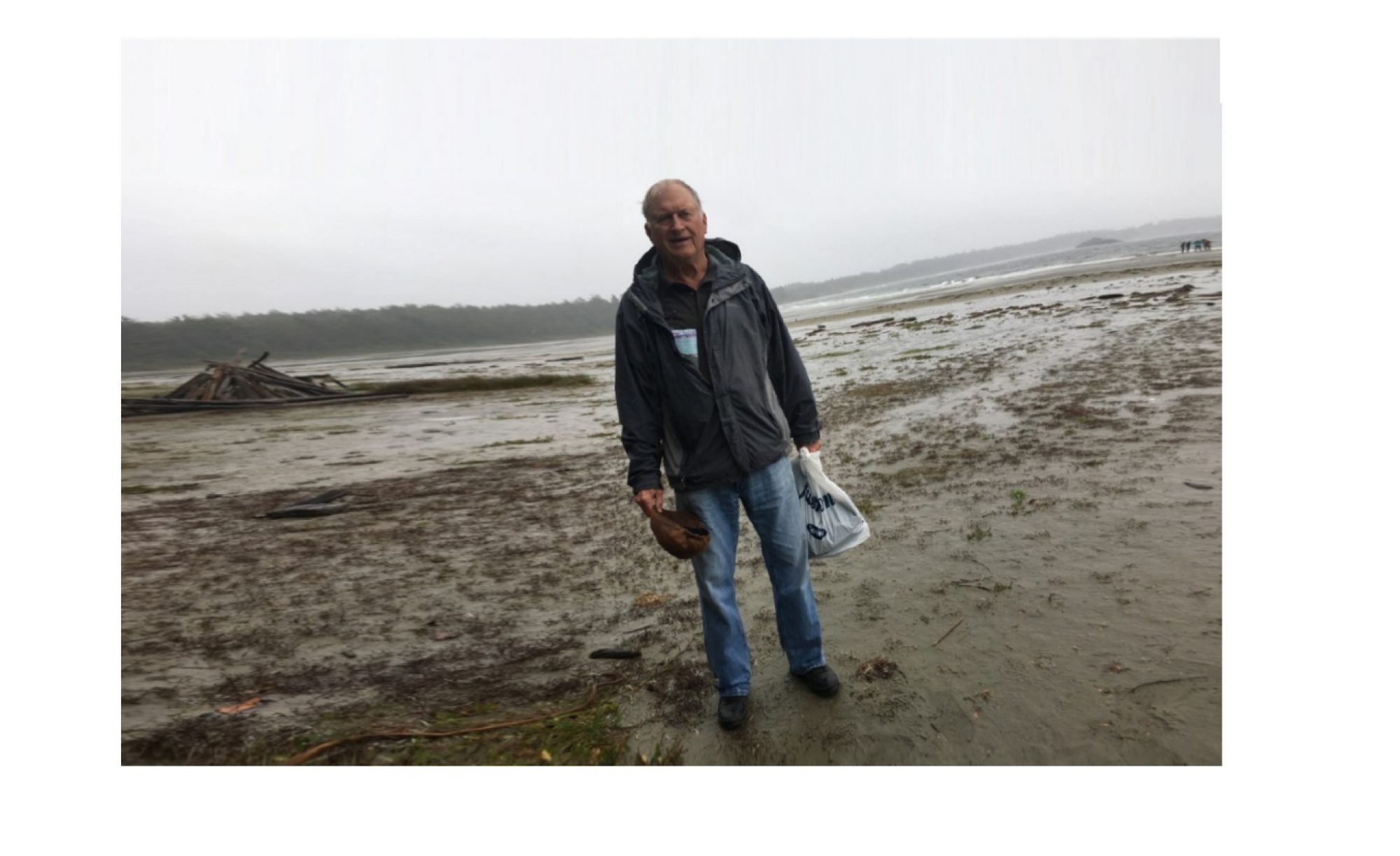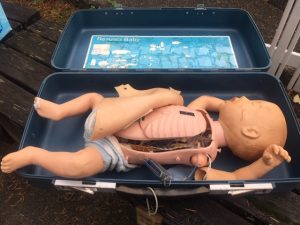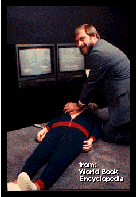By 1984, I was living in Seattle, and I had given talks and demonstrations – and even keynotes – for many national computer groups, medical groups, and training groups in the U.S. Then Europe caught wind of our CPR simulator. For the U.S. audiences it was a program with psychic benefits. Save a life, right there at a party, or in the street. The simulator let you try CPR hands on, and gave you feedback. In addition, the gaming crowd felt that it gave an extra dimension to computer advances. Later, when I also tried to put together games, some academics felt I had abandoned my noble callings with CPR. Don’t know that I felt as guilty as they wanted me to feel.
The European fascination with my CPR system began slowly. Personal computers were fairly new to that side of the world, and the first to see the CPR system were the technology scouts. At first it was just the odd foreign visitor to shows like the National Association of Broadcasters in Las Vegas, which attracted some quaint Frenchmen mostly turning their noses up at all American media , but then stopping fascinated when I broke out the manikin and the videodiscs and showed what real human-machine interface could do. Or the Germans, who were standoffish at these shows but had a finely honed curiousity about things mechanical and logical. The Japanese crowded around in groups as if my demonstration was a roulette table, and in fact, in Las Vegas at least, the roulette tables were never far away. There on the floor of exhibition halls, people could move in close and touch everything.
Other U.S. conferences were of a different nature, like the TED MED conference in Charleston in 1985. At the time Richard Saul Wurman had pioneered his Technical and Entertainment Design shows, which were goddawful expensive at the time — about $7,000 a seat by my recollection — attracting CEOs who wanted to hobnob with other CEOs and with none of the riff-raff of mid-level professionals who were curious to steal any bit of technical or market knowledge. Jonas Salk of polio fame was to be keynote at the Charleston affair, and several other medical luminaries were on the program, to present no more than ½ hour each as I remember. I remember being trapped in the Green Room with a guy who professed to be President Clinton’s nutritionist. I think Clinton had largely ignored him and ate a lot of Big Macs, but the guy carried on as if he had saved half of California from lurking calories. I guess we were all sort of prima donnas with our 30 minutes of fame. I’d met Jonas Salk once in California at the La Jolla Institute that my cousin John ran, when I was wandering in from Vietnam. Salk and I didn’t have much in common that first time, and this time around he was dead. Died about a week before his keynote at that TED MED conference.
Anyway, these various U.S. demonstrations sort of bred the European trips. Possibly the most interesting thing about my trips to Europe was that, unlike the States, most people did not know what CPR was. The first of my trips abroad was to London, to talk and demonstrate to the British Broadcasting Corporation Special Programs group. Hannon Foss was the leader of that and he held our talks in the same auditorium where they gave out the British version of our Academy Awards, so the seats were plush and the sound and lighting were impeccable. Hannon himself was a great big buoyant sort of guy who was curious about everything and enthusiastic about things he wished others to see. I was both a curiousity and a demonstration with highly visible message, just the thing for movie folks.
The first battle, however, was at customs. The British Customs agents had never seen a simulator manikin before, and tried to figure out how to classify it, so that they could tax it. Was I selling them? No. Why was I bringing it in? So others could see it. Did it have any animal properties? Not that I could see. They brought in supervisors and everyone had a good long look and these computers and manikins in boxes. In all it took about two hours to get through customs and I did not have to pay anything but could only stay in country 30 days. Who knows what damage a manikin could do if allowed to stay indefinitely?
And of course someone brought up the pedophile angle with the baby manikin. The London demonstrations had gone quite well and about a month later the BBC asked me if I could come back to be on “Tomorrow’s World” — which was their weekly look at technology that everyone watched religiously. I was boxing out that time slot and wondering if the BBC would send me a first class ticket to be on one of their more poplular shows, when I got a subsequent call from the producers, who had just shown my videotape to their board. They said with great regret that I would be disinvited, because a couple of board members thought the audience would not understand doing that sort of thing to a baby on national TV.
I think a number of things could have been different but for that BBC decision. It turns out that a year later the great, big-hearted Hannon Foss had a heart attack and, of all things, the local emergency people from the hospital did not know CPR and just threw him in the back of an ambulance. Hannon was dead on arrival. He might have been saved with the very CPR he was promoting through me. I guess I felt bad when I heard it, that had I been more effective I might have sparked instant awareness and a revolution in British emergency medicine – much of which at the time merely consisted of telling the patient to maintain a stiff upper lip. (Rigor mortis does that part quite well.)
Many advances in humanity may start with the well-crafted boondoggle. My CPR presentations were, in fact, boondoggle programs across Europe – “new ideas” forums where people could see and experience the bizarre directions of the Americans and yet feel safe that these disruptions would take a while to really reach their shores. In each case however, I was able to generate an extra connection, especially with medical types but actually everyone, because the Cardiopulmonary Resuscitation movement itself was much bigger than the simulator. CPR was a way to transfer life to the almost dead person, and often to resuscitate a downed heart attack victim on the spot. To this day I still get notes from someone who saw the CPR demonstrations and their boisterous old uncle collapse at a wedding, and they kept him alive. Or a description of the time an infant fell into the pool at a Hollywood afternoon pool party. A cameraman who had worked with me to capture interactive video of the baby rescue procedure, remembered where to put his fingers and how to hold the almost drowned infant, and brought it back to crying life there at the edge of the pool. To say these notes have enriched my life is an almost tearful understatement.
The French liked the idea of the interactive videodisc, and wrote up my demonstration in their computer magazine Memoires Optiques (Optical Memory). The crowd at the Memoires Optiques show was one of the most jolly I experienced in Europe. But as silly as the British had been about the baby, the life-like manikin again served to bring up the subject of interactive pornography. Why wasn’t someone doing that? Some Cambodians there wanted to enter into a joint venture and provide the very lifelike plastics needed for a totally interactive experience. Although that sort of group, at a show, prides itself on entertaining absolutely every bizarre new idea, this time I really was not interested…A spoilsport, I guess, but I could not see telling my kids that’s what I do in life.
The Cannes International Film Festival was of course, focused on cinema, so I was just a curiosity. The translators had quite the problem explaining the system, which I only showed on videotape there. (It loses a lot with no hands on.) I will always remember Cannes because it was the first time I had a room with a little refrigerator full of drink mixes and little bottles of whiskey and gin and vodka so I could experiment. The winter weather was cold in Nice, and I even made a hot bath and lined up my new favorite drinks along the side of the tub, and practically melted in the booze and hot water. In my silly state, I marveled how thoughtful these people are, providing me with any drink I could want from my own little hotel stash. Honestly, I was so naïve I thought it was free. The bill when I checked out told me otherwise.
I met Aske Dam at one of the Las Vegas shows which he haunted, always trying to pick up new and cool technology to take back to Europe. Aske was one of those Europeans who spoke several languages and stayed at the leading edge of video technology. He brought me and the CPR System first to Copenhagen, where he had pioneered television Bingo and (I hope) made a few schekels at that. At a University in Copenhagen I met one of the princes of Greenland. Denmark had parts of Greenland as a protectorate, I think. And then a few days later, Aske heard from a group he wanted to me to present to in Norway. We talked a lot on the boat from Copenhagen to Olso.
Aske had run the 5,000 meters for Denmark in the Tokyo, Olympics and there met his Japanese flight attendant wife and had a son. They were divorced now, but the son was flying for a Japanese Airline. I put on the talk for some video producers outside Oslo in an enchanted forest where Aske’s current girlfriend was a glassblower. The ovens for the molten glass had to maintain a high temperature and it was on a fast flowing stream which was necessary, apparently, for cooling the molten glass. She had to tend the ovens every day and never let them go cool, so she and Aske did not travel much together.
On another European trip, because of some weather disturbance, my TWA flight from Barcelona to Amsterdam was going to detour and fly over part of the Mediterranean. In one of their international spats, Mohamar Khadafy told Ronald Reagan he would send out jet fighters to shoot down any US commercial aircraft that flew over the Mediterranean. Everyone waiting for my TWA flight absorbed that news, and hurried over to change their tickets to KLM. The KLM flight was quickly packed to overloaded and the TWA flight had only – me. I was probably too slow to get on KLM and unfortunately had to be in Amsterdam for an event, so I stayed on TWA and tried to make a brave front of it.
After all, I was an American and who was this Khadafy to try to bluff us out of the skies? Turned out to be my greatest ever airplane flight. They put me in First Class (all alone) and three female flight attendants all bought my courageous line and all vied to make me most comfortable… and to bring me drinks and grapes and nuts and lots of pillows. (And I’m certain that showed Khadafy what a real American man he was up against.)
Those days I was a sort of evangelist for interactive media. An evangelist has to have something to believe in, and I did. And an evangelist is out to make others believe as strongly. I cannot claim credit for the power of interactive media, or for the value of CPR to benefit lives in the emergency empowerment it gives the ordinary citizen. The combination, however, of the Good, and the Technical was a message that I hope resonated in its day, and can keep on being a standard for every new thing we see.


